Are you struggling with getting your employees to use your SOPs? Well, you’re in luck!
We’ll be going over the 5 most common reasons your team might not be using your SOPs and breaking down the solutions you can start implementing today. Your SOPs will not go unnoticed again.
Let’s dive in!
tired of your team not using your sops?
I’m the business owner. I’m the team leader. I’ve spent so much time creating these beautiful SOPs, these policies, these procedures, and then no one uses them. Does that feel like something you can relate to?
If it is, I feel like we need to take a moment, step back and regroup. If you are creating SOPs and your team is not using them, there are probably a few things happening under the hood that can help make you less frustrated and your team a little bit happier as well.
In this article, we’re going to talk through five different ways we can get your team to use your SOPs. And, no, it’s not going to be by strong-arming them or making some punitive system if people don’t use them.
From that outcome, we’ll try to figure out what the root problem might be and give you a tactical way to solve it. For each situation, we’re going to provide a strategy for approaching that problem and a specific tactic that you can go out and implement this week to help your team if they’re struggling with these kinds of issues.
Now, before we dive into the actual types of issues we could be solving today, let’s make sure we’re on the same page as what we mean when I say SOP.
SOP: an acronym or initialism that stands for Standard Operating Procedure
That’s basically just a fancy business term for a recipe AKA how you do something. You probably have a recipe from your grandparents for making pancakes or cookies or something bakery-ish. If we were to put a business-y spin on it, that recipe is a standard operating procedure. (Need a deeper dive into what an SOP consists of? Check out this video: What is an SOP?)
So, if you have people on your team who you need to follow a recipe and, for whatever reason, they are not, stay tuned.
Reason #1: Your team views SOPs as optional
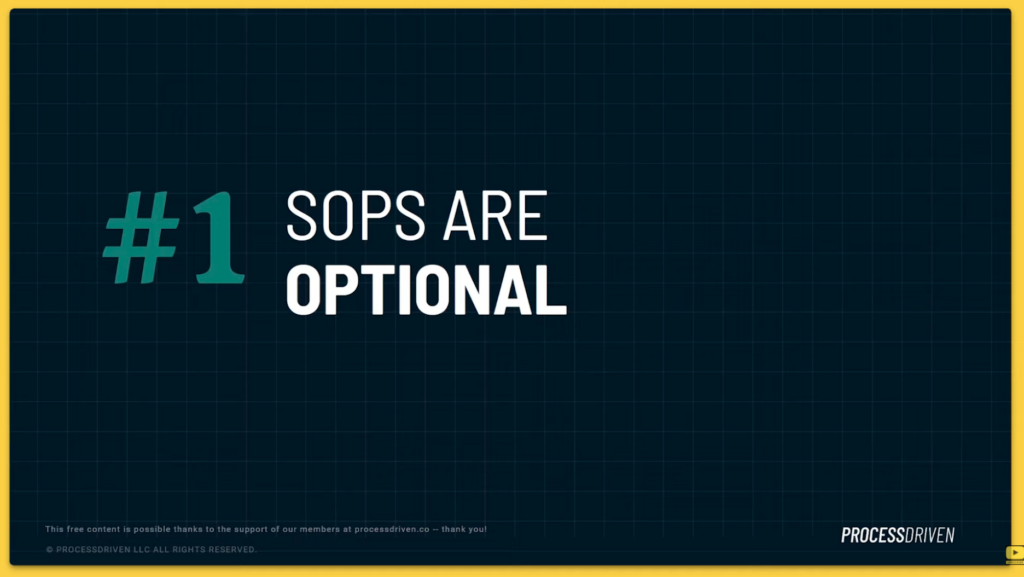
The first reason someone might not be using the SOP you have so painstakingly made is that your team views SOPs as optional.
They’re there, but you don’t have to use them. They’re just something the business owner likes to have.
This is no good because if team members don’t think there’s a reason to use something and don’t see the value in using it, they’re not going to.
solution
We need to look to ourselves in our communication and consistency to solve this issue.
If we say today that SOPs are necessary and not optional, we need to live and breathe that through the following months, years, and decades of our team operations. Our strategic objective to solve this issue is to clarify to everyone that SOPs are not optional and that they are essential.
So, how do we actually do that?
One tactic I would suggest you implement inside your business this week is giving yourself a restriction. Limit yourself and all other team leaders, advisers, or people reviewing projects to only give feedback on work through the lens of an SOP.
Rather than saying, “Hey, I noticed that you use title case on the YouTube video title, but we always use sentence case. Can you fix it to the correct sentence case? Great, thank you.”
I suggest you say, “Hey, the title for the YouTube video looks off. It’s not following step two of the SOP. Here’s the link to the SOP. Could you fix it?”
Do you see how that’s a subtle difference?
Rather than repeating yourself and regurgitating the SOP, you simply say, “Hey, this isn’t right. Use the SOP to make better decisions.”
So, we’ve demonstrated why SOPs are not optional, and we’ve also shown that we, as leaders and as people giving feedback, are using SOPs every time we think about performance.
This point of SOPs being viewed as optional is often why leaders think SOPs are not being used. Leaders’ most common assumption is, “Oh, my team just doesn’t understand how important these are.”
In reality, this is usually the least common reason. It’s the one leaders think of the most, but it’s very rare to find in a real business. The problem with this is if we believe this is the issue and we start responding with this kind of mandate presence of making it clear that these are not optional, requiring SOPs for different things, we might cause other issues to worsen if this isn’t actually the root reason.
Let’s move on to the four other reasons your team might not be using your SOPs.
To follow along with Layla on this topic, start watching at 02:00.
Need some guidance creating SOPs for your team? Download our 109 Time-Saving SOPs Every Team Needs Checklist!
reason #2: Your team doesn’t know they exist
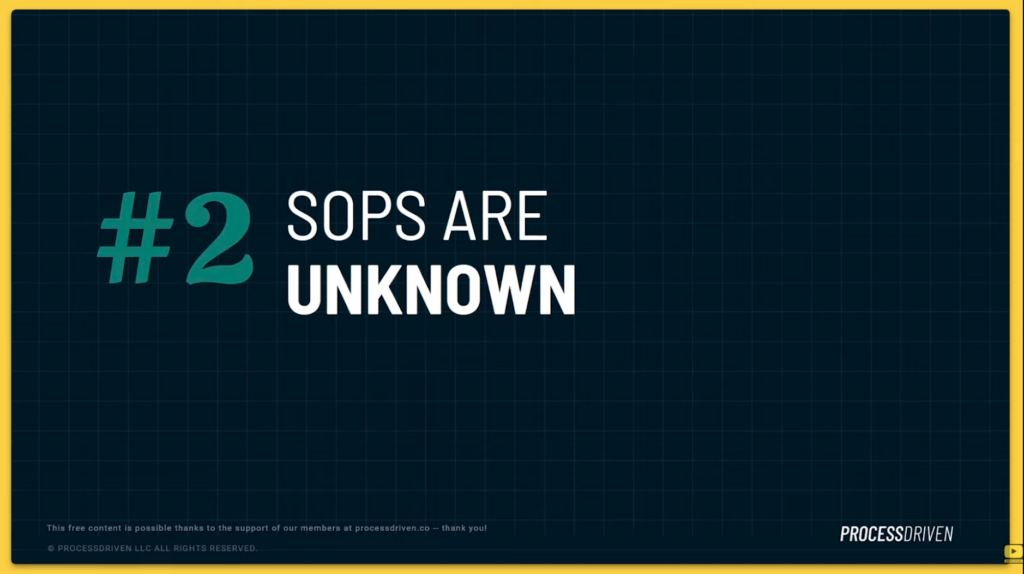
Reason number two your team is not using your SOPs is because they don’t know they have any.
This is super common for teams where the team leader or the business owner gets into a flurry, and all of a sudden, they create all these Loom videos or these Google Docs, and they throw them all over the place in different tools. They’re surprised when the team isn’t using the videos they made one afternoon two years ago in July because the team has no idea that SOP exists, let alone what they exist for and where they are.
If a team member doesn’t know that an SOP exists, how are they supposed to use it?
solution
Luckily, this is a very easy one to fix. We need to approach our SOPs just like any other data: we should try our best to centralize our information into one place where we know where to go, so we know where to find things.
One easy way to think about this is to picture yourself trying to cook something. Imagine you have some spices in your kitchen, a few in your bedroom closet, some more in the garage, and the rest in the basement. You’re trying to cook your signature chili, and you’re trying to find all the different spices you’ll need.
How likely would you look in all four rooms to find the spices you need?
If you’re as lazy as I am for cooking, you’d probably find whichever spices are close enough and say, “You know what? We’re making chili with just paprika this time around.”
You’d make do because it’s so inconvenient to look in all these places to find the things you need. Let’s not make it that inconvenient for your team. Give them a spice cabinet — one dedicated spot for all of your SOPs to live. Bonus points if whatever that spot is is easily searchable.
It’s easy for us to sit here and say, “You should have all of your SOPs in one cloud-based, centralized, easy to access, and easy to edit spot.” And I can even tell you, “Hey, I think ClickUp is a great tool for that. That’s what we teach our clients to do in the ProcessDriven Membership.”
But that’s a huge ask, right? That’s a lot of work to get everything all centralized. For this quick win, the tactic I want to recommend is even smaller.
We know that centralizing our SOPs will be good for everybody. Short of doing that, one tactic you can implement to make sure that SOPs are not unknown is linking them together whenever you have a task that has an SOP for it.
Let’s imagine you had a task to send a weekly newsletter and an SOP for how to send that newsletter — link them together. Put a hyperlink to the SOP inside the task. Whether your tasks are created inside a project management tool like ClickUp, Asana, or Trello, or whether your to-dos are a piece of paper, you can write down, “Go to Google Drive to find the SOP here.”
It doesn’t matter where it is, but as long as you make that necessary link, you ensure that your SOPs will not be unknown because whoever sees that task will know, “Ah, there’s an SOP.”
Want to see why we recently switched from storing our SOPs in ClickUp Docs to recording them as “tasks”? Check out this video: 5 Reasons I Quit ClickUp Docs for SOPs.
To follow along with Layla on this topic, start watching at 04:51
Reason #3: your sops aren’t helpful
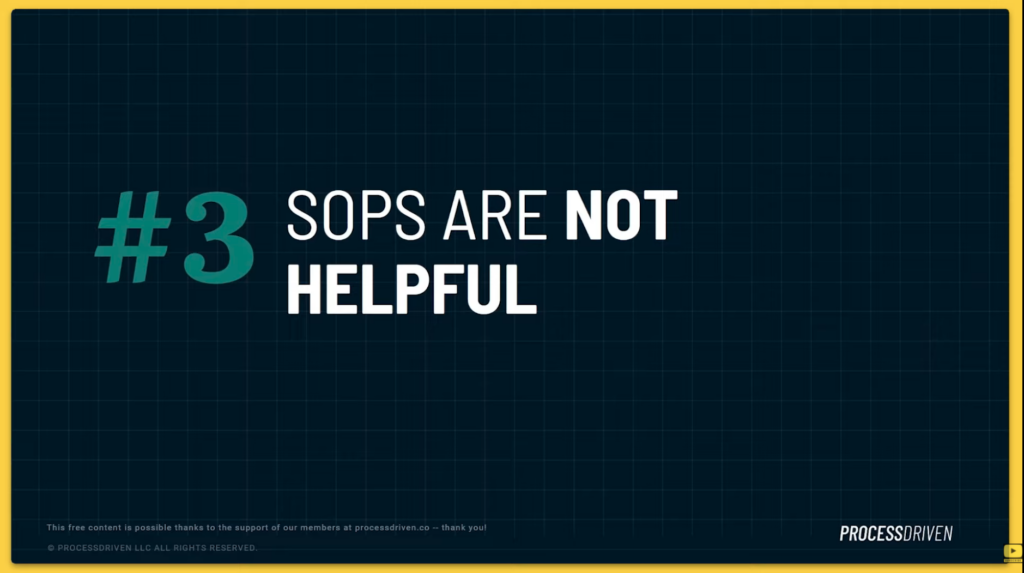
What happens if your SOPs are known?
People know they’re essential, yet they don’t want to use them because they’re not helpful. This is perhaps one of the most painful reasons for leaders to come to terms with.
You’ve written the SOPs, and you give this beautiful document over to your team, and you think it’s God’s gift to man. This fantastic piece of material that you’ve spent so long on. If someone were to tell you, “I’m not using the SOP because it doesn’t help me,” that could be hard to hear, but you need to hear it.
The main reason SOPs are viewed as not helpful is usually that the SOP and the worker’s needs are not aligned. Maybe we’re creating an SOP for work where we don’t need one, such as creative knowledge work.
If someone wrote an SOP for how to consult about ClickUp in a strategy session, that would be a bit hard to swallow because there’s so much skill and thinking on your feet that happens that an SOP wouldn’t be that helpful.
At the same time, the opposite can also be true. We could create complex SOPs so broad that someone trying to do that task doesn’t even understand what it’s trying to say. It’s like reading an encyclopedia — there’s so much information that they don’t know what to do with it.
An SOP, just like a recipe, is there to help someone accomplish something. If it’s not at the right level of detail to help that person do something, then what’s it for? It just becomes bureaucratic paperwork, and we don’t need that at this stage of business that you are at.
solution
To get beyond this not helpful SOP stage, strategically, I want us to start thinking about making sure that SOPs are made by and for doers, not leaders.
To be clear, SOPs absolutely help leaders, business owners, and managers. As we talked about before, they become a tool for guiding feedback. They become the way you live out your strategy, vision, purpose, and values. It’s the embodiment of all the strategic stuff you do like that kind of person in your business.
However, that is secondary to the primary purpose of SOPs.
The primary goal is to make the worker’s life easier, set them up for success, and help them do a great job. You should help them know what they need to do; whether it’s their first week on the job or they’ve been there ten years, those SOPs are for them. It’s for their ability to get the job right every time. To make this stuff so easy that they can focus their creative juices on what they need it for.
SOPs are for the team, not for the leader. We need to address that at the strategic level before getting tactical.
So, what is our tactic where we can start implementing this if we feel that unhelpful SOPs are our issue?
That’s easy: Allow the people doing the work to create the SOPs.
Most of the time, leaders and managers don’t know enough about the boots-on-the-ground experience to write an excellent SOP and understand what the worker needs. So, unless you are the person doing the work, get out of that SOP writing seat.
If the workers are writing the SOPs, we guarantee it’s written at a level of complexity that they understand. We also know it will be written to emphasize the things that they actually need because they’re the ones writing it.
Perhaps most importantly, when doers write the SOP, they have that sense of ownership. They’re the person who wrote this beautiful work of art, so they’re more likely to use it and advocate that others use it. Whereas the leader already has that kind of intrinsic buy-in by being a leader. They don’t need that extra investment in the SOPs. Leave that to the doers.
relinquish control
I know many of you are probably listening to me say, “Let the workers create SOPs,” and you’re freaking out. Maybe because you’re used to a more top-down approach to systemization, and we talk a lot about the bottom-up approach.
If that sounds like you, I suggest you read this article. It goes over the steps that we recommend for systemization and SOP creation in detail.
What does it look like to have the team involved in SOPs? And why is it so much of a time saver versus doing it yourself? I promise, as a leader, you still have some oversight here. However, the results are way better if you can get over that sense of giving up a bit of control.
To follow along with Layla on this topic, start watching at 07:51
Need some guidance creating SOPs for your team? Download our 109 Time-Saving SOPs Every Team Needs Checklist!
Reason #4: YOUR SOPS ARE UNTRUSTWORTHY
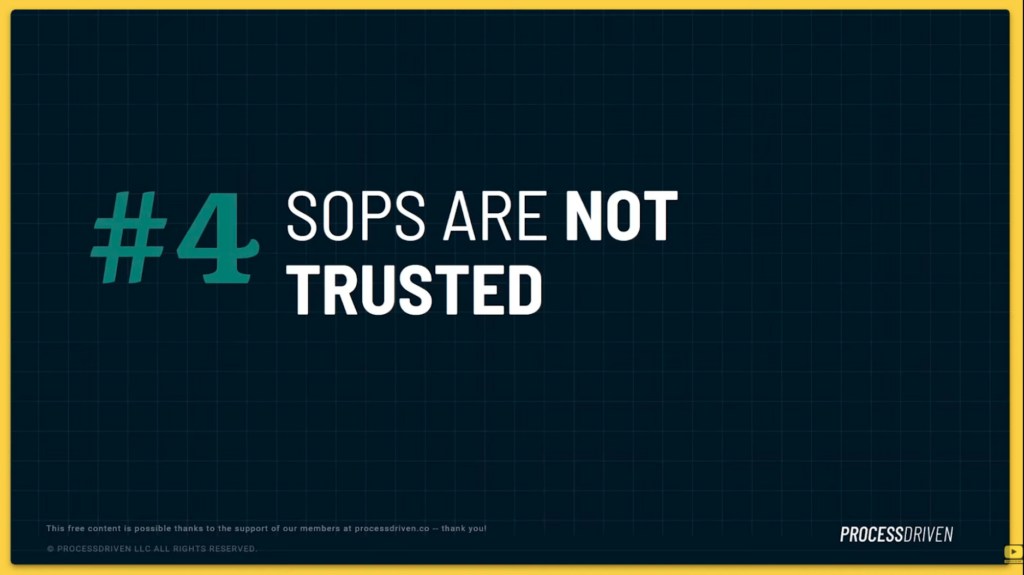
Related to control, let’s talk about trust because that is the fourth reason people are not using your beloved SOPs. They don’t trust them.
Maybe they think they’re helpful, know where they are, and think they’re important, but the last time they used the SOP, it was outdated. It then led them to do the wrong thing. Now, they’re resentful because the SOP is not something they have confidence in.
To make sure SOPs are trustworthy, we need to start talking about our culture around updating SOPs. Rather than treating SOPs as these sacred documents, treat them more as a communal workbench.
If something is wrong on that workbench or in that shared tool, teach your team that it is okay to ask. That it is encouraged to highlight the inefficiencies, to highlight the confusing parts, and not just treat an SOP as a Bible that you can’t alter or edit. You just worship and follow everything that it says.
That’s no good.
When we have a view-only policy toward our SOPs, we get into a culture where SOPs are ignored because they are outdated, and there’s no easy path to update them.
solution
The solution for this is pretty simple.
Wherever you create your SOPs, make sure there is a way to leave comments in that same spot and give whoever’s using the SOP at least commenting access. For example, if your SOPs are in a Google Doc, use the commenting features built into Google Docs to allow users to comment on that document.
If you have your SOPs printed out in a binder, allow people to put sticky notes on top of that binder to make changes or suggestions.
If your SOPs are video recordings, like Loom or YouTube videos, please don’t do that. That’s a terrible idea. I have a whole video right here ranting about why videos are terrible SOPs. This issue of being unable to update the video content is the biggest one. Editing videos is a pain.
If a screenshot changed in a tool, if our SOP changed slightly, the last thing I would want to do is go update a 30-minute video to change one step of the process. So, I’m not going to. I’m going to let it get out of date.
Would you want to do that?
If not, do not create your SOPs, which are meant to be updated constantly, in a video.
To follow along with Layla on this topic, start watching at 12:47
reason #5: your team memorized the sops
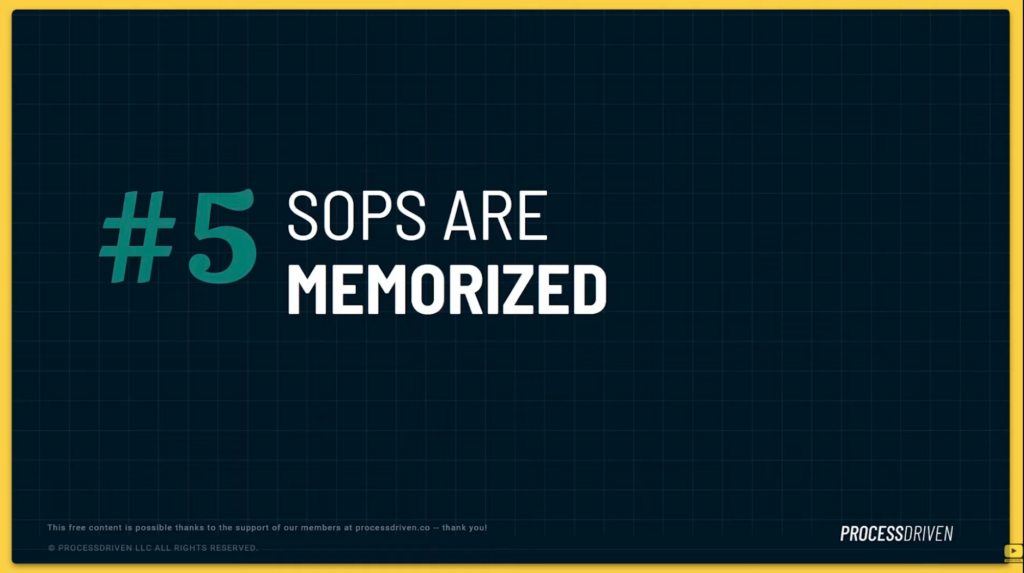
The fifth reason your SOPs might be ignored is that they’ve been memorized.
If you have somebody using an SOP and they’ve been doing the same process for a long time, it becomes pretty standard that they’ll stop referencing that SOP as they’ve started just to memorize the key steps.
This in and of itself isn’t always a bad thing. There are times when you just know what you need to do, and having that reference open is entirely unnecessary because you’re like a machine.
You know exactly what your next move is. However, when we are using SOPs from our memory, there’s a risk that our memory might falter. We might forget something, might not see that the SOP was updated because we’re not using it, or we might change our process as we go organically and then not update the SOP for the next person.
So, as much as SOPs being memorized isn’t intrinsically wrong, it can lead to risk later.
solution
There is a strategy here if this is something you’re facing. This is probably counter to what many of you would think to do, but make your SOPs skimmable. We’re suggesting this so that if somebody is very familiar with the process, they can still use the SOP, but they only need to look at keywords.
So, even if you’re someone who knows exactly what you’re doing, you might pop open the SOP just to check on the big items, even though you know how to do each of those items.
When we see people create SOPs that are long, endless, and everything is formatted the same, we know this isn’t very user-friendly. It’s great for beginners, and everyone else is drooling by the time they get to the bottom of the page. (Looking to create your SOPs faster? Check out: SOP Example: How to write a Standard Operating Procedure – FASTER!)
So, when we are trying to solve this memorization issue, let’s focus on making the SOP timeless by making it easy to skim. Our tactic for this one is to implement a sanity checklist. Now, this could be per SOP or task. The idea is that you make your SOP super easy to skim. At the very bottom, you say, “You know you’re done when…” and then you have a brief checklist on whatever result you expect.
Let’s say you have an SOP for uploading a YouTube video. You have a long SOP that goes through all the detailed steps of what you need to do. In the end, the sanity checklist says, “You know you’re done when the video is uploaded, the monetization is set correctly, the info cards are set correctly, and the description is set correctly.”
We don’t get into how to do any of that. It’s just the last gut check to confirm that if you didn’t read all the stuff above, you at least got the correct result in the end. It’s kind of like a quiz. Rather than reading the textbook, you just take the quiz and hope you get a good score. That’s what the sanity checklist is all about.
One of the best examples is recording a YouTube video. We have a sanity checklist for recording YouTube videos, and almost every time, miraculously, a step is forgotten. When going to mark the task complete, ClickUp, which is the tool we use here, yells at me and says, “Are you sure you’re done? You didn’t take a thumbnail image.” Ah, shoot. Okay, go ahead and do it.
To this day, it’s still helpful to have that sanity checklist for the processes done every week. It’s hard to emphasize how helpful these are because they really are, no matter what stage you’re at.
As a bonus, tactic number two is changing the process. Start experimenting if you find that people are falling asleep when it comes to your email newsletter process. It’s probably a sign that you haven’t done enough innovation in that process recently.
Try throwing in a curveball. For example, change your strategy around what you’re using for subject lines and revise that SOP. That’s an excellent way to keep people on their toes because you’re giving them something fresh to handle each time.
conclusion
We’ve gone over five reasons why your team might not be using your SOPs.
For almost all of these, if you haven’t gathered, there’s nothing evil or menacing or “bad employee” about this. It’s more so your expectations and what the person’s expectations are not lining up somehow. By tweaking our daily habits just one percent, you’ll find that most of these issues will just resolve themselves. You just need to make those tiny, incremental improvements.
Until next time, enjoy the process.
Need some guidance creating SOPs for your team? Download our 109 Time-Saving SOPs Every Team Needs Checklist!
